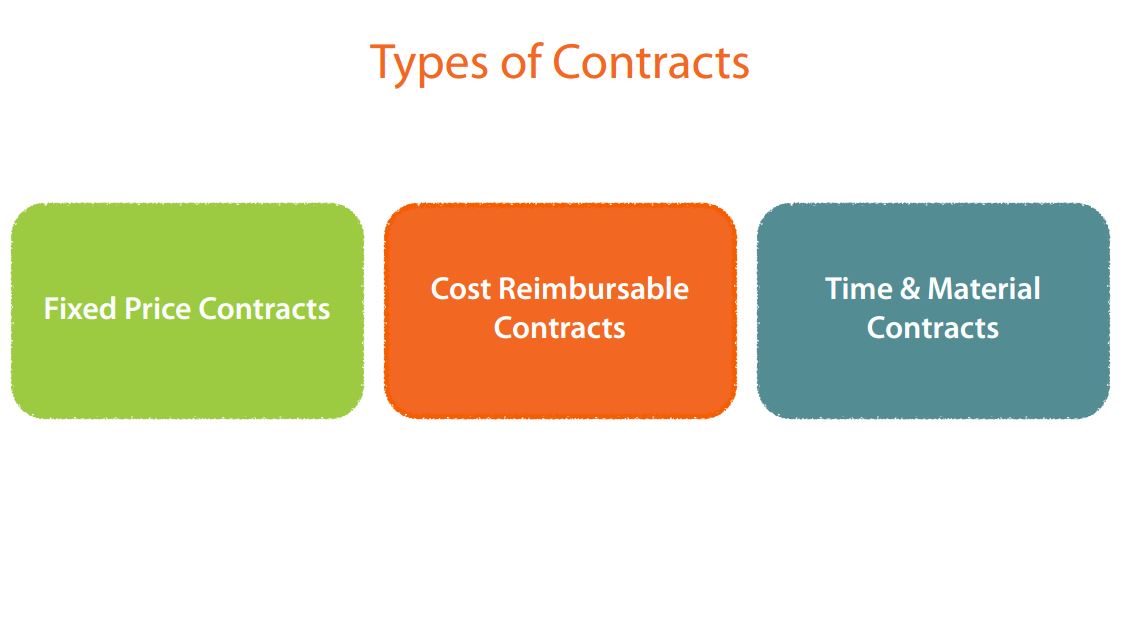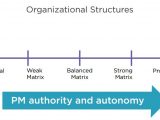
Types of Contracts according to PMBOK® Guide – Sixth Edition
28 April 2020Table of Contents
Types of Contracts according to PMBOK® Guide – Sixth Edition
The nature of the relationship between a buyer and seller in a procurement setting will be dictated by the type of contract that’s used.
Generally speaking, there are three main types of contracts that are common in procurement situations :
- Fixed price contracts
- Cost-reimbursable contracts
- Time & Material Contracts
1. Fixed price contracts
In a fixed price situation there is a precise price that’s paid for work and this price is predetermined before work on a project begins. You’ll find this price within the contract and it will agreed to by both the buyer and the seller from the outset.
The seller will be legally required to deliver procurement objectives at that set price. Conditional incentives can be incorporated into fixed price contracts.
So we can have bonuses for things like completing the project on time or meeting secondary objectives related to feature set or quality. However these incentives are just that. Bonuses that can be stacked on top of a set baseline that is meant to cover the vast majority of work within the contract.
When the scope changes for what procurement work is to be completed, cost can be revised and a new fixed price can then be set.
There are advantages and disadvantages for both customers and sellers when it comes to the fixed price model.
For the customer, the exact cost for the work has been pre-negotiated and the customer is shielded from any cost overrun liability that might emerge. Here we might even be willing to pay a slight premium over what we might be able to pay if we simply paid on a time and material or on some sort of other basis. But we know that we’ve locked in our cost and that that’s all we are going to be responsible for as a project team.
Some of the advantages for the seller are that they can receive some or all of the money upfront, depending on the terms of the contract they sign. In many cases you can even have terms as simple as receiving half upon signing of the contract, and half upon completion.
Furthermore the seller is in a position to financially plan for the entire project, which is more difficult in a time and material sort of setting where perhaps there are limits on a time rolling basis.
For example only being able to spend a certain amount each week or month without an idea of exactly how long it will take to complete all project work given those sort of limitations, especially if those limitations shift over time.
Disadvantages of this approach for the customer, include the fact that scope changes can be challenging to implement and that the seller may be more likely to default especially in cases where we’ve done a poor job of selecting our seller or in creating our contract.
Scope changes are challenging to handle because if we want additional work to be done, the seller has a legitimate right to both refuse and to object to this notion. They’re receiving a certain amount of money to complete a certain amount of work. If you want them to complete more work on a project, then well, you’d better expect to pay them more to do so.
Further because we have detached ourselves from any cost overrun liability, and placed it all on the seller, if things were to go wrong during procurement, or during their project from the seller’s point of view, they’re more likely to default rather than go additionally into debt or take additional losses, in order to complete project work.
This is especially true if we haven’t been upfront with all of the requirements or if we haven’t answered all of the seller’s questions, such that they can create an estimate that’s both fair to us as customers and reasonable for the amount of money they should expect it to cost to complete the procurements they’re agreeing to.
From a seller’s side, these disadvantages are clear. Scope changes can be challenging to handle because we end up disappointing our customers if we disagree with making additional changes without additional money.
In many cases you may have run into circumstances where a client has been disappointed or where you’ve received pushback from a vendor of your own, when it comes to accomplishing more work than was initially found within a contract plan.
It’s important to realize that sellers aren’t necessarily just being argumentative when they don’t agree to scope changes but instead simply looking out for their own organization’s best interest.
That’s especially the case since the seller inherits all liability for cost overruns on the procurement. If you go back and change the terms of the contract to pay the seller more, then they’ll certainly be more amenable to making any additional changes or expansions to scope.
Because of this, expect to make changes to your contract and to the amount paid if expansion and scope is to occur.
There are three main types of fixed price contracts that are often employed by organizations :
a) Firm Fixed Price Contract (FFP) :
This is the most common type of contract, where the seller is liable for all cost increases unless they’re related to changes in scope, that would require us to renegotiate our contractual terms. Here we are paying a set amount for a set solution. And it’s just that simple.
b) Fixed Price Incentive Fee Contract (FPIF) :
In a fixed price incentive fee contracts or FPIF, the price ceiling may include performance bonuses that are set during contracting. However a set floor is also already in place, guaranteeing that a minimum amount will be paid to the seller simply for completing project objectives.
The seller may earn bonuses on top of that initial floor, by meeting price, schedule, or other objectives that might arise so it can all be negotiated prior to the contract being signed.
c) Fixed Price with Economic Adjustment Contract (FP-EPAs) :
These contracts are used in long-term contracting situations most normally. They allow for payments to be adjusted based on inflation, commodity pricing, or other factors that can be objectively measured and tracked over time.
For example, we might’ve agreed to a long-term shipping contract with a procurement source. But as part of this we agree to not only pay a set fee, but also a fuel surcharge based on a common published commodity pricing source that gives us an idea of how much oil or another sort of fuel index might rise or fall over the course of the project.
2. Cost reimbursable contracts :
In this case the seller is paid for all eligible costs that they incur and they are also paid a fee, which represents the seller’s margin for the project work. Conditional incentives can be incorporated in these kinds of contracts as well.
Cost reimbursable contracts are often favored because they allow for more flexibility and changes to scope than would be possible within the fixed price model. Looking at advantages for the customer, this is one of the primary ones.
There’s more flexibility on the scope and objectives of what needs to be completed. So in cases where we may not go in from the beginning knowing exactly what we want the seller to accomplish, we often will turn to cost reimbursable contracts.
Furthermore the transparency related to how these costs are accounted for allows for greater cost control. Potentially leading to additional savings versus what would be possible in the relatively black box environment of a fixed price contract, where we don’t necessarily have the right to know how much it costs the seller to accomplish their work.
From a seller’s point of view, there’s a guaranteed level of profit built into the contract either at a percentage or at a set dollar level, depending on when the project work will be completed.
The seller is also shielded from cost overruns because if the project continues to cost more than anticipated, the customer simply has to pay this difference based on the terms of the contract.
That’s one of the key disadvantages from a customer standpoint. Cost may and almost certainly will rise beyond the initial expectations for many different reasons. There can be delays in work, changes in scope, additional objectives laid into our contract, or more over time all making it more difficult to estimate how much we’ll end up spending in this relationship.
From a seller’s point of view, the disadvantages primarily that there may be a need to adapt the changes and project scope more often. We may be compensated for this but it may be against some of our own strategic objectives as a seller, when these sort of changes have to occur.
As was the case with fixed price contracts, there are three main types of cost reimbursable contracts as well.
a) Cost plus fixed fee contract or CPFF :
Here all allowed costs are reimbursed from the buyer to the seller. In addition a flat fee is paid on completion to the seller, either in the form of a set dollar amount or a percentage of total cost incurred.
This fee will represent a percent of the initial budgetary estimate so there’s still some incentive built in for the seller to complete work as originally scheduled, as their profit won’t be set to increase even if additional cost rise.
b) Cost plus incentive fee contract or CPIF :
In this case all allowed costs are again reimbursed from the buyer to the seller, and performance bonuses are awarded when certain objectives are met. Typically these relate to completing project work at a certain time, under a certain cost threshold, or with a certain level of quality.
A common example of this type of contract is when cost-savings are shared in between the buyer and the seller. For example the buyer may wish to further incentivize the seller to find ways to save money on the project by offering them a 50/50 split of any money that’s saved, that allows the project to be completed below the initial budget.
c) Cost Plus Award Fee contracts, or CPAF :
These are a little bit different in that all allowable costs are once again reimbursed, but an award fee is granted based on performance. This is different than the flat fee that might be paid in a CPFF standpoint, or the incentive fees that might be paid with CPIF structure.
The criteria for this sort of award fee to be paid, is typically more subjective in nature, and often times is exclusively up to the discretion of the buyer. So the buyer gets to determine whether or not this award has been earned based on the work completed by the seller.
3. Time and Material contracts:
This is a hybrid of the fixed and cost reimbursable contract types. Often times time and material contracts are used for external staffing such as when working with consultants.
The scope of work to be completed is typically not fully known at the outset of work or when we put in an agreement into action. As such we can either use more or less of our procurement sources time based on what work we determine must be completed.
Most of the time, time and material contracts will include limits that help to protect the buyer from cost upsides. For example, once we hit a certain rate of funding for a certain month, we may simply have hired that team or that consultant on a full-time basis and use all of their time and not be liable for any additional hours they have to work beyond that maximum that’s been set.
There are some advantages and disadvantages to this approach as well. From a customer standpoint it allows for more flexibility and scope and objectives to be completed, just like with our previous cost reimbursable contract structure.
The transparency also allows cost control to take place. We know how many hours we’re being billed for and we can make certain that work is being completed at a rate we find satisfying for that time.
From a seller perspective, it’s very clear that the seller is compensated based on the amount of work performed. If I work four hours as a seller, I will receive four hours pay and so on and so forth.
From a customer standpoint cost may rise beyond initial expectations for many different reasons. Especially if work takes longer than initially expected, or requires more materials than we’ve accounted for.
From a seller’s point of view, the scope of the work and the extent of financial opportunity is typically uncertain.
Think about entering a project as a consultant without much understanding of whether there’s one, three, six months or years worth of work to be completed. Because the buyer doesn’t really know what it is they’re looking for exactly at the outset.
Without that in mind we often see that consultants might have higher hourly rates given that they’re not certain to continue working on a long-term and stable basis, and instead must plow more of their time into developing additional relationships and finding additional work opportunity








